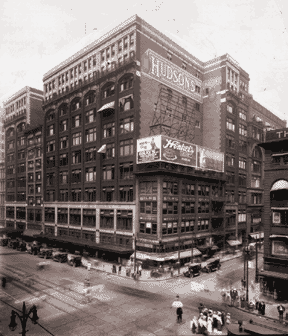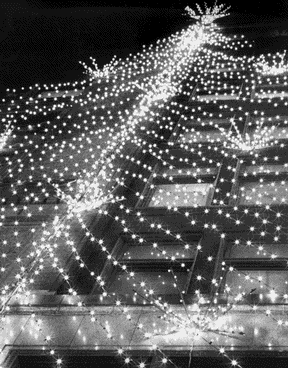HOW J. L. HUDSON CHANGED THE WAY WE SHOPPED...

In 1911 Hudson opened the store on Woodward. Some laughed, saying the new location was too far from Jefferson, which at that time was considered the center of downtown. Only Hudson himself believed his new store would become the heart of Detroit.
The next year, on a trip to his native England, Hudson, who had never married, died of pneumonia. His four nephews, all Webbers, took over his store and continued his exhuberant customer-pleasing ideas.
On Armistice Day 1923, Hudson's unveiled a giant American flag on the side of the store: -- 3700 square feet with eight-foot wide stripes and five and half-foot stars. The huge flag visited the U.S. Capitol Building in 1929 and the World's Fair in 1939 before it was retired in 1949.
The second large flag weighed 1,600 pounds, used 2,038 yards of wool and covered seven stories of the Hudson building. The flag was 104 by 235 feet, and on its debut in 1950 required 55 men to hang it. In 1976, the nation's bicentennial, it was retired and was donated to the Smithsonian Institution, which gave it to the American Flag Foundation in Houston.
From The Detroit News: http://apps.detnews.com/apps/history/index.php?id=29#ixzz1Jdh6s3eN
In 1924, Hudson's sponsored the first Thanksgiving Parade, beginning a long and beloved annual tradition. Charles Wendel, display director at Hudson's, started the popular event after seeing festive carnival parades in Europe and Toronto. It was considered to be a benefit of working at Hudson's to be chosen to be among the parade marchers.
The parade which heralded the arrival of Santa Claus rivaled New York's Macy's Parade as the nation's favorite. But it was expensive and by 1979, the parade was turned over to Detroit Renaissance. Parade expenses are now shared by hundreds of local sponsors.
By 1953 the 49-acre store had 12,000 employees and was making 100,000 sales per day. It used as much electricity as the city of Ypsilanti. It had a legendary delivery force of 500 drivers and 300 trucks. It boasted five restaurants which made 14,000 meals per day. The Hudson's Maurice salad delighted lunchers for many years, its recipe a closely guarded secret until the store bowed to thousands of requests and made it public.
From The Detroit News: http://apps.detnews.com/apps/history/index.php?id=29#ixzz1Jdhmu9YP
In keeping with the founder's 'more and better' philosophy, Hudson's opened the world's first shopping center, Northland, March 22, 1954, in the city of Southfield. This huge suburban mall offered parking for 10,500 cars to shoppers who were lured to the mall by its 53 stores, including Hudson's. The complex eventually grew to more than 125 stores and helped transform the way the nation shopped. Other malls quickly opened in the Detroit suburbs.
But the downtown store still reigned supreme. The Hudson's Fireworks displays soon topped the large flag in grandeur. Record crowds gathered to oooh and awww as the world's largest fireworks display marked the Fourth of July and Canada Day in a joint International Freedom Festival.
Another popular event, 'The Good Old Summertime,' spilled the store's shops onto the downtown sidewalks. Clerks with handlebar mustaches dressed in striped shirts straw hats and hawked fun stuff. Gibson-style girls sold wares at garage sale prices. The main idea was always to please and attract a crowd of happy customers.
Despite warning signs, the downtown store hung in there. In 1961, the 25 story building was the world's tallest department store. It had five basements, 51 passenger elevators, 17 freight elevators, 51 display windows, 706 fitting rooms, 2 million square feet, and 5,000 drafty windows. And the customers loved it.
In 1962, the store had two $1 million dollar sales days, topping the branches. In 1963, the founder's great-nephew, Joseph L. Hudson Jr. took over and opened the store's fine art gallery and a fine wine department.
He also reached out to Detroit's growing minority community. In 1960, a Cass Tech student became the first black bus girl in the basement cafeteria. Her name was Diana Ross.
From The Detroit News: http://apps.detnews.com/apps/history/index.php?id=29#ixzz1Jdicux6W

In 1964 the nine-story Christmas tree of lights went up the side ot the building. It was 125 feet tall with 72,000 starburst lights that invited shoppers to join the Christmas spirit inside. For most Detroiters who grew up in that era, the 'real' Santa was at Hudson's. The store's Christmas decorations sparkled and delighted everyone. The outside windows featured animated displays from fairy tales to outer space.
In honor of the dawn of the space age in the 1960s, Santa's helpers put on space suits. The 12th floor fantasy area entertained the long lines of excited children and their parents, who received photo keepsakes of their tots on Santa's lap. Little did they know that there were several santas working together to keep the lines moving.
Perfection was never good enough. The Christmas decorations were new each year. Out of sight from the customers, the old decorations were smashed at the end of each season. It was cheaper to destroy them than to store them.
![]() But things were changing in downtown Detroit. The convenience of the suburban stores took much of the business away from the downtown store. In 1966 a Hudson's clerk was murdered in the store. The Detroit riot of 1967 made many shoppers afraid to come downtown. Hudson's merged with Dayton Corp. in 1969 to form the Dayton-Hudson Corp.
But things were changing in downtown Detroit. The convenience of the suburban stores took much of the business away from the downtown store. In 1966 a Hudson's clerk was murdered in the store. The Detroit riot of 1967 made many shoppers afraid to come downtown. Hudson's merged with Dayton Corp. in 1969 to form the Dayton-Hudson Corp.
The 1970s were worse. The downtown store's water bill was more than the total of Hudson's 15 other stores. But, still the store stayed open, quietly stopping a service, closing a department, shutting a floor, changing a policy. By 1977 half of the store's display windows were closed.
The People Mover built a stop at Hudson's, but to no avail. In 1982 the store had its last Downtown Detroit Days shopping fest. In January 1983 it closed, ending a 102 year run.
From The Detroit News: http://apps.detnews.com/apps/history/index.php?id=29#ixzz1Jdicux6W

|
The king was former B-movie actor and film trivia master Bill Kennedy. He aired films daily, and his Sunday afternoon show regularly attracted more than half Metro Detroit's viewers -- even up against pro football.
For 30 years, Kennedy wowed Detroiters with his blinding plaid jackets and encyclopedic knowledge of movies, stars and Hollywood gossip. Viewers would call in with questions that he would answer off the cuff or not at all - "How d'ya expect me to know that?"
Some of his shows were taped, but he left all his mistakes intact. Mistakes enhanced his reputation and he knew it. He added corrections later in his show.
From The Detroit News: http://apps.detnews.com/apps/history/index.php?id=25#ixzz1JdlnmqNU
